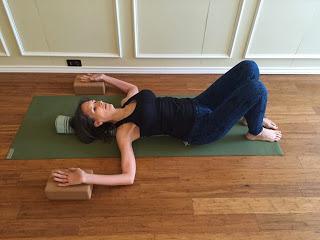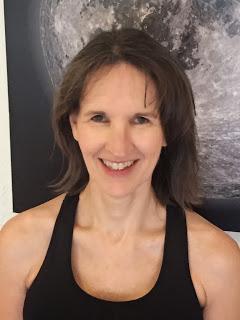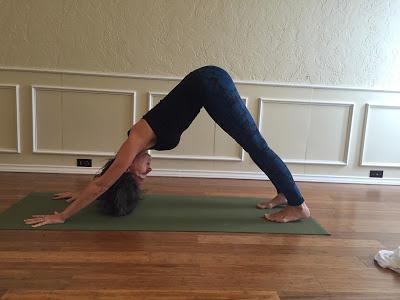 I was diagnosed with breast cancer and in February 2014 I had a double mastectomy. At age 54, the mastectomies were my first major surgery. As any of us yogis know, our breath—including basic breath awareness and simple, calming forms of pranayama—is the practice we can always turn to, so my breath was my regular companion during the various tests and while waiting in pre-op. As a yogi, who temporarily on medical leave, one flame that flickered within me was the desire to return to my physical practice. I mentally visualized Adho Mukha Svanasana (Downward-Facing Dog pose) as my goal. For me, finding my lost dog meant an open chest, shoulders, armpits, and straight arms, none of which I could access after surgery. I couldn’t even shrug my shoulders! I’ve never been motivated by the repetitious nature of lifting weights or the thought of 100 sit-ups to tone my muscles. But Vinyasa yoga offers me creativity, freedom of movement, and a spiritual aspect to taking care of my body.
I was diagnosed with breast cancer and in February 2014 I had a double mastectomy. At age 54, the mastectomies were my first major surgery. As any of us yogis know, our breath—including basic breath awareness and simple, calming forms of pranayama—is the practice we can always turn to, so my breath was my regular companion during the various tests and while waiting in pre-op. As a yogi, who temporarily on medical leave, one flame that flickered within me was the desire to return to my physical practice. I mentally visualized Adho Mukha Svanasana (Downward-Facing Dog pose) as my goal. For me, finding my lost dog meant an open chest, shoulders, armpits, and straight arms, none of which I could access after surgery. I couldn’t even shrug my shoulders! I’ve never been motivated by the repetitious nature of lifting weights or the thought of 100 sit-ups to tone my muscles. But Vinyasa yoga offers me creativity, freedom of movement, and a spiritual aspect to taking care of my body. For those of you going through a similar journey (or who are teaching people recovering from this surgery), I’ve recreated a summary of my physical journey with recommendations for initial poses after the breast surgery. As you practice, you should not feel pain but might notice a pulling or stretching sensation. Please review this or any other plan for exercise with your surgeon, especially if you’ve experienced complications, began reconstruction using tissue expanders, or had lymph nodes affected by surgery.
First Things FirstWhile drains remain, walk at a comfortable pace as much as an hour a day (less if you did not exercise regularly prior to surgery). Moving helps the body heal, increasing blood flow and oxygen. Don’t do any weight bearing or lifting with the arms but reach outward (with the remote!), upward (to wash your hair), or behind you to put on a jacket. Avoid letting others do what you can do for yourself, even if it takes longer. Use deep breathing to reduce physical tension and to gently expand the chest muscles. Practice engaging the muscles used to shrug your shoulders, possibly rolling them up and back several times a day. As you release the shoulders, imagine your shoulder blades pulling down toward your waist. Approximately 10-14 Days After SurgeryBegin light stretches at this time (even if drains remain). Walking your hands up a wall is the best post-surgery “asana,” and officially recommended by all experts.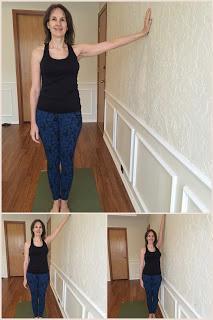 Stand with your arm on the effected side at a 90 degree angle to the wall. Walk your hand upward and hold for about five breaths (3-5 sets). Repeat about 3 times day. As your shoulder opens, move your hand above your head along the wall and inch the outer edge of your foot closer. A fully extended arm with hip touching the wall is the final pose, which may take several months to achieve. Ask permission to move your arm higher than your shoulder from your surgeon, often approved around two weeks. Use breath awareness or an extended exhalation for each of the stretches with the goal of releasing tension in your body as you hold the stretch. The next stretch requires reaching your elbow behind your body. You can grasp a strap (or a towel) in one hand and take it behind your back (arm straight or slightly bended). The other hand reaches behind to grab the other end of the strap. Walk the hands toward each other along the strap. Allow your shoulder blades to move toward each other. Don’t arch your back, and allow your tailbone to move toward your heels. Turn your palms away from the body. Over time, you may be able to interlace your fingers behind your back.
Stand with your arm on the effected side at a 90 degree angle to the wall. Walk your hand upward and hold for about five breaths (3-5 sets). Repeat about 3 times day. As your shoulder opens, move your hand above your head along the wall and inch the outer edge of your foot closer. A fully extended arm with hip touching the wall is the final pose, which may take several months to achieve. Ask permission to move your arm higher than your shoulder from your surgeon, often approved around two weeks. Use breath awareness or an extended exhalation for each of the stretches with the goal of releasing tension in your body as you hold the stretch. The next stretch requires reaching your elbow behind your body. You can grasp a strap (or a towel) in one hand and take it behind your back (arm straight or slightly bended). The other hand reaches behind to grab the other end of the strap. Walk the hands toward each other along the strap. Allow your shoulder blades to move toward each other. Don’t arch your back, and allow your tailbone to move toward your heels. Turn your palms away from the body. Over time, you may be able to interlace your fingers behind your back. 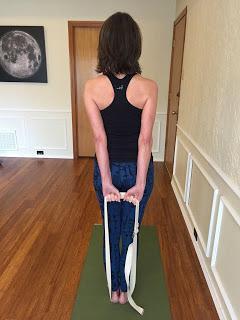 This photo shows an advanced version with heels standing on the strap (looped), hands grasping the top of the strap (palms out). Elbows move toward each other as your chest opens over time. As your body allows, your elbows may bend slightly, pointing straight behind. The third stretch uses a strap or towel in both hands (try gripping with palms up and down). Reach your arms in front, in line with your shoulders or lower if needed (review video). Raise your hands (arms straight or slightly bent) upward toward ceiling until you reach the edge of your flexibility. Keep your arms no higher than shoulder height until the drains are removed. Keep your spine long with your tailbone pointing toward your heels and your lower ribs stacked below the others.
This photo shows an advanced version with heels standing on the strap (looped), hands grasping the top of the strap (palms out). Elbows move toward each other as your chest opens over time. As your body allows, your elbows may bend slightly, pointing straight behind. The third stretch uses a strap or towel in both hands (try gripping with palms up and down). Reach your arms in front, in line with your shoulders or lower if needed (review video). Raise your hands (arms straight or slightly bent) upward toward ceiling until you reach the edge of your flexibility. Keep your arms no higher than shoulder height until the drains are removed. Keep your spine long with your tailbone pointing toward your heels and your lower ribs stacked below the others.
You can also do these lifts on your back with knees bent and soles of feet on the floor. Arms above your head can be helpful to reduce swelling if lymphedema is a concern. Another option for this stretch is to face the wall and walk your hands upward, inching closer to the wall as your body allows. These stretches are pre-cursors to Child’s pose (Balasana) and Downward-Facing Dog pose.End with a restorative pose with the arms out to the side and your elbows bent in Cactus arms (in line with shoulders) or in the shape of a “W” if your elbows need to move lower (toward your hips).